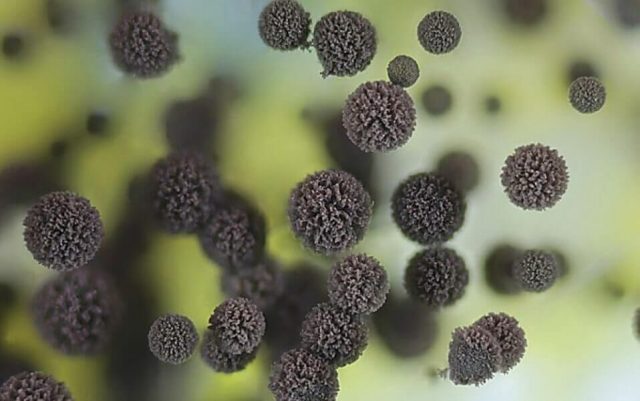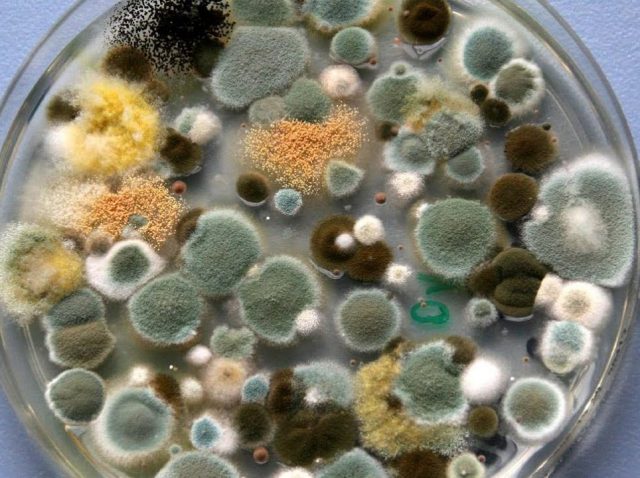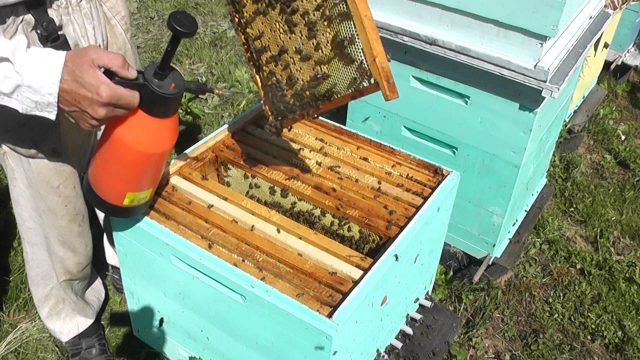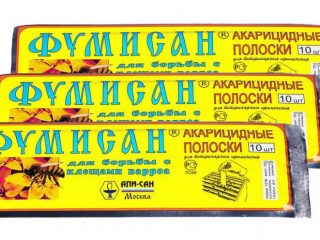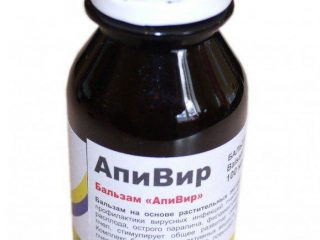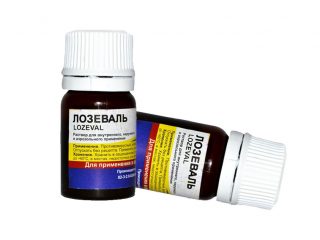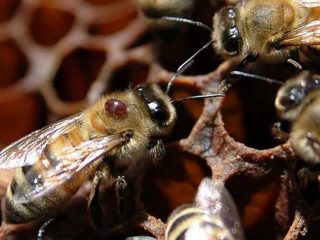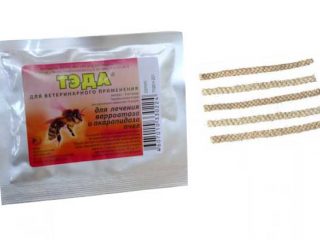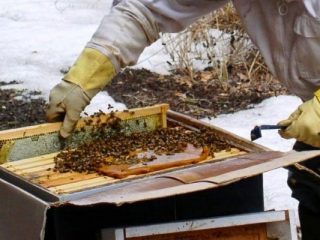Content
Bee aspergillosis (stone brood) is a fungal disease of bee larvae of all ages and also of adult bees. Although the causative agent of this infection is very common in nature, the disease of bees is rarely detected in beekeeping. Its appearance is usually associated with a period of active honey harvest or wet spring weather. But the consequences of infection can be severe. To prevent this from happening, you need to take measures to combat the fungus as quickly as possible.
How dangerous is the disease?
Bee aspergillosis can spread very quickly. Having appeared in one family, within a few days the infection can affect all the hives in the apiary. The disease is equally dangerous for bees, birds, animals and humans. The disease affects the mucous membranes of the organs of vision and breathing, mainly the bronchi and lungs, as well as the skin.
Once in the body of the larva, aspergillosis spores affect it in two ways:
- the mycelium grows through the body of the larva, weakening and drying it out;
- a toxin is produced that has a destructive effect on the nervous and muscle tissue of the brood.
After a few days the larvae die. Aspergillus enters the body of brood and bees along with food or through external damage to the body.
Pathogens of aspergillosis in bees
The disease is caused by the yellow fungus Aspergillus (Aspergillus flavus), widespread in nature, and less commonly by its other varieties: Aspergillus niger and Aspergillus fumigatus. The fungus grows on plants and organic dead remains. It is a mycelium of long hyphal fibers, which rise above the nutrient medium by 0.4-0.7 mm and have fruiting bodies in the form of a transparent thickening. Aspergillus flavus colonies are greenish-yellow, niger colonies are dark brown.
Methods of infection
Aspergillus fungus spores live almost everywhere: in the ground, on its surface, on living and dead plants. Being on the anthers and nectaries of flowers, the spores along with pollen are picked up by foraging bees and delivered to the hives. Further, worker bees easily carry them on their legs and hairs and pass them on to other adults and larvae when cleaning and feeding. The fungus multiplies on honeycombs, bee bread, larvae, pupae, and adult bees.
The following conditions contribute to the manifestation of aspergillosis:
- air temperature from +250From to +450WITH;
- humidity above 90%;
- rainy weather;
- large grass stand;
- location of houses on damp ground;
- weakened bee colony;
- poor insulation of hives.
Aspergillosis of bees is most common in spring and summer, since it is during this period that all the circumstances provoking the disease appear.
Signs of infection
You can find out about the appearance of stone brood in bees by the appearance and condition of the larvae. The incubation period lasts 3-4 days. And on day 5-6 the brood dies.Having entered the larva's body through the head or between segments, the fungus grows, changing its appearance. The larva becomes light cream in color, wrinkled and without segments. Due to the fact that the moisture in the larva is actively absorbed by the fungal mycelium, the pupa dries out and feels hard (stone brood).
The fungus forms spores on the surface of the dead larva, and depending on the type of fungus, the larva becomes light green or dark brown. Since the mycelium of the fungus tightly fills the cells, the larvae cannot be removed from there. When the disease is advanced, the fungus covers the entire brood, and the cell lids look like they have collapsed.
Adult bees are most often affected by aspergillosis in the spring. They first become excited and move actively, their respiratory movements in their abdomen increase. After a little time, sick bees weaken, cannot stay on the walls of the honeycombs, fall and die after a few hours. Externally, insects infected with aspergillosis are almost no different from healthy ones. Only their flight becomes heavier and weaker.
The mycelium of the fungus, growing in the intestines, permeates the entire body of an adult bee. It also grows behind the head in the form of a kind of collar. When the abdomen and chest of a dead insect are squeezed, it is discovered that they have become hard. Due to mold growth, dead bees appear more furry.
Diagnostic methods
The diagnosis of “bee aspergillosis” is made on the basis of the characteristic external signs of dead brood and adults, as well as after microscopic and mycological studies. The research results are ready in 5 days.
At least 50 sick bees or corpses from fresh dead bees and a piece (10x15 cm) of honeycomb with sick and dead brood are sent to the veterinary laboratory in glass jars with tight lids. Delivery of the material must be carried out within 24 hours from the moment of its collection.
In the laboratory, scrapings are made from the corpses of larvae and bees to detect sporulation of the aspergillosis fungus. Laboratory tests exclude the disease ascopherosis.
How and with what to treat stone brood in bees
When the veterinary laboratory confirms the disease “aspergillosis,” the apiary is declared unsafe and quarantine is imposed. In case of minor damage, appropriate treatment of bees and brood is carried out. They also disinfect the entire bee farm.
In isolated cases of death of larvae, the honeycombs along with the bees are moved to a dry, warm and disinfected hive. Then bee aspergillosis is treated with special drugs, as for ascopherosis, approved by the Department of Veterinary Medicine:
- "Astemizole";
- "Askosan";
- "Ascovet";
- "Unisan".
Of all the listed drugs, only Unisan can be used independently. In other cases, it is recommended to entrust treatment to specialists.
To use Unisan, 1.5 ml of the product is mixed in 750 ml of sugar syrup prepared by mixing sugar and water in a ratio of 1:4. Spray with Unisan solution:
- the walls of the hive inside;
- occupied and empty cells;
- frames on both sides;
- bee colonies with brood;
- beekeeper's equipment and work clothes.
The procedure is repeated 3-4 times every 7-10 days. Processing must be completed 20 days before the start of honey collection. "Unisan" is a safe product for humans. After such treatment, honey is suitable for consumption.
Before the treatment of bee aspergillosis begins, sick colonies are strengthened. If the uterus is sick, then it is replaced with a healthy one, the nest is reduced and insulated, and good ventilation is organized. The bees are provided with a sufficient amount of honey. If there is a lack of honey, feed with 67% sugar syrup.
When working with infected bees, beekeepers, in order to avoid contact of fungal spores with mucous membranes, must take all precautions and wear a robe, a damp 4-layer gauze bandage on the nose and mouth, and protective glasses over the eyes. After finishing work, you need to wash your face and hands with soap, and boil your work clothes.
Processing hives and equipment
If bee colonies are severely affected by aspergillosis, they are destroyed by smoking with sulfur dioxide or formaldehyde, and the insulating material with canvases and honeycomb frames are burned. Considering the rapid spread of aspergillosis in bees, as well as the danger of the disease for the entire apiary, the following treatment of hives and equipment is carried out:
- physically cleaned of debris, corpses of bees and larvae, propolis, wax, mold and mildew;
- treated with a 5% formaldehyde solution or a blowtorch flame;
- the soil under the hives is dug up with the addition of a 4% formaldehyde solution or a clarified bleach solution;
- gowns, face nets, and towels are disinfected by boiling for half an hour or soaked in a 2% hydrogen peroxide solution for 3 hours, then washed and dried.
To treat the hive with a 5% formaldehyde solution, you need to add 50 ml of the substance, 25 g of potassium permanganate and 20 ml of water to a small container. Place the container in the hive for 2 hours. Then treat the hive with 5% ammonia to remove formaldehyde fumes.
Instead of a blowtorch, you can use a heat gun. Using a hot air gun eliminates the risk of fire, and the air temperature can reach up to +800WITH.
After disinfection measures, the hives and all equipment are washed well and dried thoroughly. If the honeycombs can still be used, then they are processed in the same way as all inventory. In case of severe fungal damage, the honeycombs are melted into wax for technical purposes.
The quarantine is lifted a month after the complete destruction of aspergillosis of bees in the apiary.
Set of preventive measures
In order to prevent aspergillosis in brood and bees, you need to adhere to certain rules and perform a number of preventive measures:
- before installing the hives, the land area must be treated with lime for disinfection;
- keep only strong families in the apiary;
- place the apiary in dry, well-lit places;
- avoid thick grass;
- for the winter, reduce nests and insulate them well;
- during the absence of honey collection, provide the bees with nutritious food;
- keep the houses clean, ventilated and dry;
- do not carry out any activities with the hives in cold and damp weather;
- Do not use antibiotics to strengthen bee colonies, which weaken the immune system of insects.
High humidity in hives at any time of the year is the worst enemy for bees and can lead to a fatal disease. Therefore, the apiary should have dry and warm houses all year round.
Conclusion
Bee aspergillosis is a dangerous disease for any bee farm. It can affect not only the brood, but also adult bees. Every beekeeper needs to know the signs of this disease, methods of its treatment and precautions in order to combat it in a timely and effective manner.
